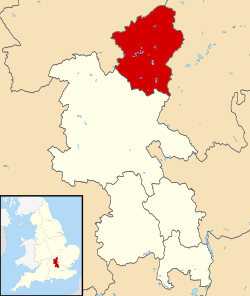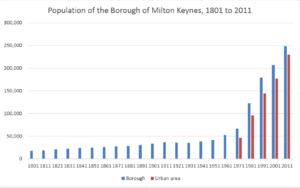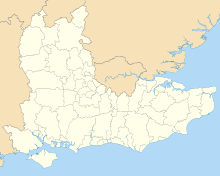Borough of Milton Keynes
| Borough of Milton Keynes | ||
|---|---|---|
| Borough, unitary authority area | ||
| ||
| Motto: By knowledge, design and understanding | ||
 Milton Keynes shown within Buckinghamshire and England | ||
| Sovereign state | United Kingdom | |
| Constituent country | England | |
| Region | South East England | |
| Ceremonial county | Buckinghamshire | |
| Admin HQ | Milton Keynes | |
| Founded | 1 April 1997 | |
| Government | ||
| • Type | Unitary authority | |
| • Governing body | Milton Keynes Council | |
| • Mayor (ceremonial) | Derek Eastman[1] | |
| • Leadership: | Leader & Cabinet | |
| • Executive: | Labour Minority | |
| • MPs |
Iain Stewart (C) (Milton Keynes South) Mark Lancaster (C) (Milton Keynes North) | |
| Area | ||
| • Total | 119.16 sq mi (308.63 km2) | |
| Population | ||
| • Estimate (2013) | 255,700[2] | |
| Time zone | Greenwich Mean Time (UTC+0) | |
| Postcode | MK | |
| Area code(s) | 01908 | |
| ONS code | 00MG | |
| Website |
www | |
The Borough of Milton Keynes is a unitary authority area and borough of the ceremonial county of Buckinghamshire. It is the northernmost district of the South East England Region.
It borders the non-metropolitan counties of Buckinghamshire (the area under the control of Buckinghamshire County Council), Bedfordshire and Northamptonshire. The principal settlement in the borough is Milton Keynes itself, which accounts for about 33% of its area and 90% of its population.
History
The district was created on 1 April 1974 under the Local Government Act 1972, by the merger of Bletchley Urban District, Newport Pagnell Urban District and Wolverton Urban District, Newport Pagnell Rural District and that part of Wing Rural District within the designated New Town area. The district council applied for and received borough status that year.
It was originally one of five non-metropolitan districts of Buckinghamshire, but on 1 April 1997, under a recommendation of the Local Government Commission for England it became a self-governing unitary authority, independent from Buckinghamshire County Council.
Local government
Arising from the local government elections of May 2015, Milton Keynes council is under no overall control; the Labour Party has the greater number of seats but not an overall majority. As of May 2015, the Borough is governed by a Labour minority administration The Conservative Party is currently the main opposition group.
Following the United Kingdom local elections, 2015 the political composition for the council is as follows.
| Conservatives | Labour | Liberal Democrats | UKIP |
|---|---|---|---|
| 22 | 23 | 12 | 0 |
The election did not change the status of the Council from 'no overall control'.
Economy
This is a table of trend of regional gross value added (GVA) of Milton Keynes at current basic prices published (pp. 240–253) by Office for National Statistics with figures in millions of British Pounds Sterling (except GVA index).
| Year | Regional Gross Value Added | Agriculture | Industry | Services | GVA index per person |
|---|---|---|---|---|---|
| 1995 | 2,834 | 7 | 751 | 2,075 | 135 |
| 2000 | 4,166 | 5 | 805 | 3,356 | 141 |
| 2003 | 5,203 | 7 | 852 | 4,344 | 147 |
^ 1 Components may not sum to totals due to rounding
^ 2 includes hunting and forestry
^ 3 includes energy and construction
^ 4 includes financial intermediation services indirectly measured
^ 5 UK average index base = 100
Education
Further education in the borough is provided by Milton Keynes College. For higher education, the Open University's headquarters are based in Milton Keynes – though, as this is a distance education institution, the only students resident on campus are approximately 200 full-time postgraduates. The University Campus Milton Keynes, part of the university of Bedfordshire, provides conventional undergraduate courses.
Demographics
The Council's estimate of the population of the Borough in 2012 was 252,400[3] By 2026, the population of the borough is projected to be 302,100.[3]
In the 2011 census, 80% of the population described their ethnic origin as white (nationally 85.5%), 5.6% as South Asian (5.5%), 6.8% as black (3.4%), 3.3% as mixed race (2.2%), 3.6% as Chinese and other Asian (2.2%), and 0.6% as 'other ethnic group (1.0%).[4]
In the same census, 52.8% of the Borough's population registered their religion as Christianity and 37.9% as not religious or none given, compared to 59.4% and 31.9% nationally. 4.8% of the population follow Islam (5% nationally) and a little over 2.8% are Hindu (1.5%), with no other religion above one percent.[4]
The borough’s population age profile is slightly younger than England's average, with half of the borough’s population aged under 35 years old.[4] Nationally, half of the population is aged less than 39.[4] The 30- to 39-year-olds in Milton Keynes Borough formed as the largest 10-year age group of the population with 30- to 34-year-olds being the largest 5-year age group.[4] The Borough has a larger proportion of the population in the younger age groups; 22.3% are aged under 16 compared with 18.9% in England.[4] Meanwhile, just 11.1% of the Milton Keynes population are aged over 65 compared with 16.3% in England.[4]
Levels of educational attainment in the Borough are slightly higher than the England average. 18% have no qualifications compared with 22.5% in England, while 28.2% have a degree or higher qualification compared with 27.4% in England.[4]
Housing and home ownership
In 2011, Milton Keynes had the greatest proportion of shared ownership homes in England, 6.1%, compared with second-placed London Boroughs of Hounslow and Tower Hamlets with 2.4%. This form of home ownership has been a planning policy of the Borough of Milton Keynes soon after the settled acceptance of all major UK lenders on specified forms of this type of property ownership was agreed in the 2000s decade.
The borough has relatively high home ownership at 72.8% of dwellings with the remaining 16.2% of homes are privately rented and 11.0% are socially rented.[5]
At the 2012, 16.2% of the population lived in flats (apartments), compared with the 22.1% average for England.[4]
Settlements
Milton Keynes (urban area)

The urban area accounts for about 33% of the Borough by area and 90% by population. This is a partial list of the districts of Milton Keynes itself. For a discussion of the usage of the term "city" in Milton Keynes, see History of Milton Keynes#1960s Plans for a new city in North Buckinghamshire, 1967 designation of Milton Keynes.
The Borough of Milton Keynes is fully parished. These are the parishes, and the districts they contain, that are now elements of Milton Keynes as a whole.
- Bletchley and Fenny Stratford: Brickfields, Central Bletchley, Denbigh, Mount Farm, Fenny Lock, Granby, Fenny Stratford, Newton Leys, Water Eaton
- Bradwell: Bradwell, Bradville, Bradwell Common, Bradwell village, Heelands, Rooksley
- Bradwell Abbey: Bradwell Abbey, Kiln Farm, Stacey Bushes, Two Mile Ash, Wymbush
- Broughton and Milton Keynes (the Village) – a shared parish council: Atterbury, Brook Furlong, Broughton, Fox Milne, Middleton, Milton Keynes, Milton Keynes Village, Northfield, Oakgrove, Pineham
- Campbell Park: Campbell Park, Elfield Park, Fishermead, Newlands, Oldbrook, Springfield, Willen and Willen Lake, Winterhill
- Central Milton Keynes
- Great Linford: Blakelands, Conniburrow, Downs Barn, Downhead Park, Giffard Park, Great Linford, Neath Hill, Pennyland, Tongwell, Willen Park
- Kents Hill, Monkston and Brinklow: Brinklow, Kents Hill, Kingston, Monkston
- Loughton: Loughton, Loughton Lodge, Great Holm, the Bowl
- New Bradwell
- Shenley Brook End: Emerson Valley, Furzton, Kingsmead, Shenley Brook End, Snelshall, Tattenhoe, Tattenhoe Park, Westcroft
- Shenley Church End: Crownhill, Grange Farm, Hazeley, Medbourne, Oakhill, Oxley, Shenley Church End, Woodhill
- Simpson: Ashland, Simpson, West Ashland
- Stantonbury: Bancroft/Bancroft Park, Blue Bridge, Bradville, Linford Wood, Stantonbury, Stantonbury Fields
- Stony Stratford: Fullers Slade, Galley Hill, Stony Stratford
- Walton: Caldecotte, Old Farm Park, Tilbrook, Tower Gate, Walnut Tree, Walton, Walton Hall, Walton Park, Wavendon Gate
- West Bletchley: Far Bletchley, Old Bletchley, West Bletchley.
- Wolverton and Greenleys: Greenleys, Stonebridge, Wolverton, Old Wolverton
- Woughton: Beanhill, Bleak Hall, Coffee Hall, Eaglestone, Leadenhall, Netherfield, Peartree Bridge, Redmoor, Tinkers Bridge, Woughton on the Green, Woughton Park, Woughton village.
- Newport Pagnell lies within the Milton Keynes urban area as defined by the Office for National Statistics but is outside the 1967 'designated area' and is thus generally accepted as separate.
- Woburn Sands lies within the Milton Keynes urban area[6] as defined by the Office for National Statistics but is outside the 1967 'designated area' and is thus generally considered a separate town.
Rest of the borough
The rural area accounts for about 66% of the Borough by area and about 10% by population. Olney is a town. These are the extra-urban civil parishes:
- Astwood
- Bow Brickhill
- Caldecote, Castlethorpe, Chicheley, Clifton Reynes, Cold Brayfield
- Emberton
- Filgrave
- Gayhurst
- Hanslope, Hardmead, Haversham
- Lathbury, Lavendon, Little Brickhill, Little Linford, Long Street,
- Moulsoe
- Newton Blossomville, North Crawley
- Olney
- Ravenstone
- Sherington, Stoke Goldington,
- Tyringham
- Warrington, Weston Underwood
References
- ↑ The Mayor of Milton Keynes (2014/15) - Milton Keynes Council, 2013
- ↑ Population Statistics = Milton Keynes Council, 2013
- 1 2 Population projections Milton Keynes intelligence (MKi) Observatory
- 1 2 3 4 5 6 7 8 9 Office for National Statistics and Borough of Milton Keynes, 2011. "Milton Keynes 2011 Census Profile".
- ↑ Office for National Statistics 2011 Census Key Statistics: Tenure.
- ↑ "2011 Census – Built-up areas". ONS. Retrieved 4 July 2013.
External links
- Milton Keynes Borough Council
- Map on the Milton Keynes Council's website showing civil parishes in the borough.
Coordinates: 52°02′N 0°46′W / 52.033°N 0.767°W


